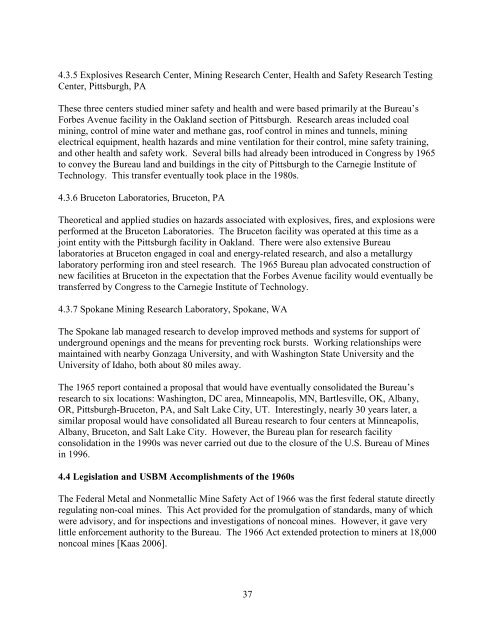One Hundred Years of Federal Mining Safety and Health Research
One Hundred Years of Federal Mining Safety and Health Research
One Hundred Years of Federal Mining Safety and Health Research
- No tags were found...
You also want an ePaper? Increase the reach of your titles
YUMPU automatically turns print PDFs into web optimized ePapers that Google loves.
4.3.5 Explosives <strong>Research</strong> Center, <strong>Mining</strong> <strong>Research</strong> Center, <strong>Health</strong> <strong>and</strong> <strong>Safety</strong> <strong>Research</strong> Testing<br />
Center, Pittsburgh, PA<br />
These three centers studied miner safety <strong>and</strong> health <strong>and</strong> were based primarily at the Bureau’s<br />
Forbes Avenue facility in the Oakl<strong>and</strong> section <strong>of</strong> Pittsburgh. <strong>Research</strong> areas included coal<br />
mining, control <strong>of</strong> mine water <strong>and</strong> methane gas, ro<strong>of</strong> control in mines <strong>and</strong> tunnels, mining<br />
electrical equipment, health hazards <strong>and</strong> mine ventilation for their control, mine safety training,<br />
<strong>and</strong> other health <strong>and</strong> safety work. Several bills had already been introduced in Congress by 1965<br />
to convey the Bureau l<strong>and</strong> <strong>and</strong> buildings in the city <strong>of</strong> Pittsburgh to the Carnegie Institute <strong>of</strong><br />
Technology. This transfer eventually took place in the 1980s.<br />
4.3.6 Bruceton Laboratories, Bruceton, PA<br />
Theoretical <strong>and</strong> applied studies on hazards associated with explosives, fires, <strong>and</strong> explosions were<br />
performed at the Bruceton Laboratories. The Bruceton facility was operated at this time as a<br />
joint entity with the Pittsburgh facility in Oakl<strong>and</strong>. There were also extensive Bureau<br />
laboratories at Bruceton engaged in coal <strong>and</strong> energy-related research, <strong>and</strong> also a metallurgy<br />
laboratory performing iron <strong>and</strong> steel research. The 1965 Bureau plan advocated construction <strong>of</strong><br />
new facilities at Bruceton in the expectation that the Forbes Avenue facility would eventually be<br />
transferred by Congress to the Carnegie Institute <strong>of</strong> Technology.<br />
4.3.7 Spokane <strong>Mining</strong> <strong>Research</strong> Laboratory, Spokane, WA<br />
The Spokane lab managed research to develop improved methods <strong>and</strong> systems for support <strong>of</strong><br />
underground openings <strong>and</strong> the means for preventing rock bursts. Working relationships were<br />
maintained with nearby Gonzaga University, <strong>and</strong> with Washington State University <strong>and</strong> the<br />
University <strong>of</strong> Idaho, both about 80 miles away.<br />
The 1965 report contained a proposal that would have eventually consolidated the Bureau’s<br />
research to six locations: Washington, DC area, Minneapolis, MN, Bartlesville, OK, Albany,<br />
OR, Pittsburgh-Bruceton, PA, <strong>and</strong> Salt Lake City, UT. Interestingly, nearly 30 years later, a<br />
similar proposal would have consolidated all Bureau research to four centers at Minneapolis,<br />
Albany, Bruceton, <strong>and</strong> Salt Lake City. However, the Bureau plan for research facility<br />
consolidation in the 1990s was never carried out due to the closure <strong>of</strong> the U.S. Bureau <strong>of</strong> Mines<br />
in 1996.<br />
4.4 Legislation <strong>and</strong> USBM Accomplishments <strong>of</strong> the 1960s<br />
The <strong>Federal</strong> Metal <strong>and</strong> Nonmetallic Mine <strong>Safety</strong> Act <strong>of</strong> 1966 was the first federal statute directly<br />
regulating non-coal mines. This Act provided for the promulgation <strong>of</strong> st<strong>and</strong>ards, many <strong>of</strong> which<br />
were advisory, <strong>and</strong> for inspections <strong>and</strong> investigations <strong>of</strong> noncoal mines. However, it gave very<br />
little enforcement authority to the Bureau. The 1966 Act extended protection to miners at 18,000<br />
noncoal mines [Kaas 2006].<br />
37
















